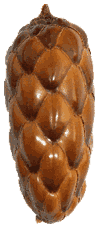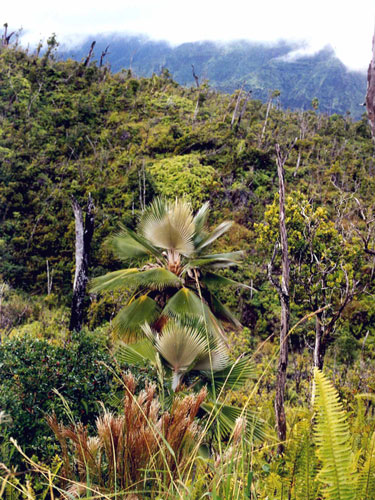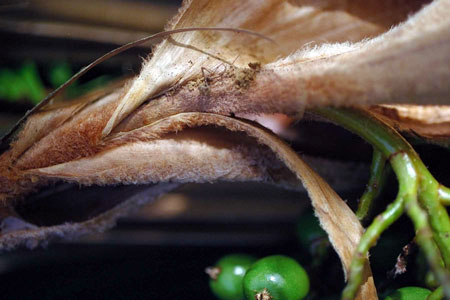 |
Palm |
 |
Palm |
 |
| Pritchardia viscosa habitat (MH Chapin) |
Kauai, Hawaii, USA
Pritchardia viscosa is a medium palm, 6 to 13 m height; the stem gray-brown with vertical striations, 16 to 21 cm DBH.
It has an open crown with ca. 10 to 20 leaves. It is the only member of the genus with flowers, buds (calyx and corolla) covered in a thick viscous as if varnished. The rachillae (flower bearing branches) are glabrous and viscous. There are one to three panicles; the peduncular bracts are wooly, dense, tan; and the inflorescence are shorter than the crown; the lower surface of the leaf blades are covered with a silvery-gray, lepidote; the ripe fruit are fibrous, black, and elliptical-pyriform, 40 x 25 mm.
Pritchardia is the only member of Arecaceae native to Hawaii with 23 known single island endemic species, and demonstrates the richest palm diversity in terms of species in the United States. All Hawaiian Pritchardia spp. possess fragrant, perfect flowers. Although there is a possibility that their pollinator(s) have become extinct (over 50% of the avifauna are extinct in Hawaii), they manage to pollinate successfully. The author has observed the endemic Kamehameha butterfly (Vanessa tameamea) visiting P. viscosa flowers. They demonstrate high seed viability if collected ripe at the time of shedding. Only three individuals remain in the wild. They grow as congeners with P. waialealeana, P. hardyi, and P. flynnii within a degraded open mesic forest with a clay-soil substrate, at 427 m elevation.
 |
| Densely wooly, tan peduncular bracts (MH Chapin) |
Predation of P. viscosa seeds occurs from introduced rats (Rattus rattus, R. exulans, and R. norvegicus). Introduced vertebrates such as deer (Odocoileus hemionus columbianus), goats (Capra hircus), and pigs (Sus scrofa) also reduce P. viscosa seedlings by grazing and uprooting them. Invasive weeds such as grasses (Paspalum conjugatum) and guava (Psidium guajava, P. cattleianum) can form weed mats and out-compete young palm seedlings. Seed harvesting and poaching by humans also occurs. One individual had permanent damage to its stem made by a person wearing pole-climbing spikes. A seedling in the population area was removed, after being observed by the author for over four years and an intentional, shovel-made hole in the ground remained. Pests and disease are a constant threat. Existing threats include the two-spotted leaf hopper (Sophonia rufofascia), and Phytophthora, as well as serious potential threats if introduced, such as the West Indian sugarcane borer (Metamasius hemipterus) or Lethal Yellowing disease and its known vector the palm cixiid (Myndus crudus).
In situ management has been conducted by the land managers, the Department of Land and Natural Resources, Division of Forestry and Wildlife (DLNR-DOFAW) with a fenced exclosure around two individuals protecting them from grazing animals and pigs, metal rat guards also circle their stems. Ex situ collections with known wild origins are maintained and protected by the DLNR-DOFAW, botanic gardens on Kauai and Oahu. Pritchardia viscosa is recognized by the Center for Plant Conservation (CPC), which provides educational awareness. Recovery plans have been thoroughly researched and produced for P. viscosa by the United States Fish and Wildlife Service (USFWS).
Recommended management strategies include: protection of in situ populations, adding rat baiting, invasive weed management and long-rang monitoring; establish new wild populations; establish effective ex situ populations; collaborate to accomplish conservation biology research; adhere to invasive weeds, pest management, and quarantine procedures. Establish reliable protocols for seed storage, including effective seed banking as a conservation tool.
 |
| Crown with inflorescences (MH Chapin) |
Melany H. Chapin, Ph.D., Bishop Museum Research Associate, Hawaii, USA.
Mike Maunder, Ph.D., Center for Tropical Plant Conservation, Fairchild Tropical Garden, Coral Gables, Florida, USA.
Athens, J.S., Tuggle, H.D., Ward, J.V. and Welch, D.J. 2002.
Avifaunal extinctions, vegetation change, and Polynesian impacts in prehistoric Hawaii.
Archaeological Oceania 37:57-78.
Beccari, O., and Rock, J. F. 1921.
A monographic study of the genus Pritchardia.
Memoirs Bernice P. Bishop Museum 8:1-77.
Burney, D.A., James,H.F., Burney, L.P., Olson, S.L., Kikuchi, W., Wagner, W.L., Burney, M., McCloskey, D., Kikuchi, D., Grady, F.V., Gage, R. and Nishek, R. 2001.
Fossil evidence for a diverse biota from Kauai and its transformation since human arrival.
Ecological Monographs 71(4): 615-641.
Chapin, M.H. 2004.
The Palms of Hawaii.
Palms & Cycads: Palm & Cycad Societies of Australia (PACSOA) 83/84: 4-10.
Chapin, M.H. 2004.
Rat damage on native Hawaiian palms.
Palms 48(3): 153-155.
Chapin, M.H., Wood, K.R., Perlman, S.P. and Maunder, M. 2004.
A review of the conservation status of the endemic Pritchardia palms of Hawaii.
Oryx 38(3): 273-281.
Chapin, M.H., Maunder, M. and Horak, K. 2006.
A preliminary study of regeneration in wild populations of threatened endemic Hawaiian palms (Pritchardia; Arecaceae).
Pacific Conservation Biology. Accepted and In Press.
Cuddihy, L.W. and Stone, C.P. 1990.
Alteration of native Hawaiian vegetation.
University of Hawaii Press. Honolulu, Hawaii.
Hodel, D. 1980.
Notes on Pritchardia in Hawaii.
Principes 24(2): 65-81.
Pritchard, H.W., Daws, M.I., Fletcher, B.J., Gamene, C.S., Msanga, H.P. and Omondi, W. 2004.
Ecological correlates of seed desiccation tolerance in tropical African dryland trees.
American Journal of Botany 91(6): 863-870.
Sakai, A.K., Wagner, W.L. and Mehrhoff, L.A. 2002.
Patterns of endangerment in the Hawaiian flora.
Systematic Biology 51(2): 276-302.
USFWS. 1996.
Endangered and threatened wildlife and plants; determination of endangered or threatened status for nineteen plant species from the island of Kauai, Hawaii.
Department of the Interior, US Fish and Wildlife Service 61(198): 53070-53089.
Wagner, W.L., Herbst, D.R. and Sohmer, S.H. 1990.
Manual of the flowering plants of Hawaii 1-2.
Bishop Museum Press, Honolulu, Hawaii, USA.
Wagner, W.L., Bruegmann, M.M., Herbst, D.M., and Lau, J.Q.C. 1999.
Hawaiian vascular plants at risk: 1999.
Bishop Museum Occasional Papers, no. 60.
Bishop Museum Press, Honolulu, Hawaii, USA.